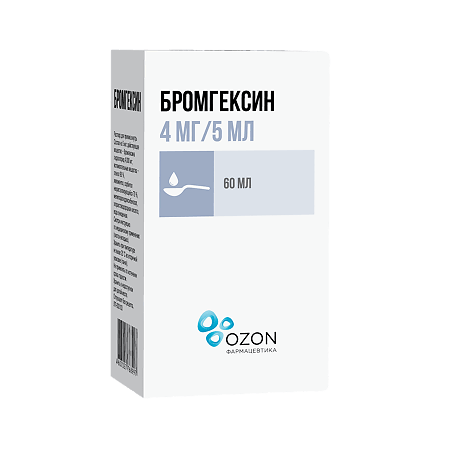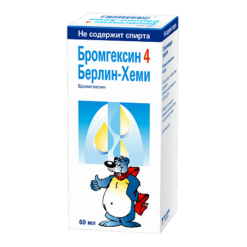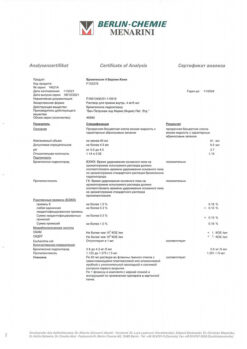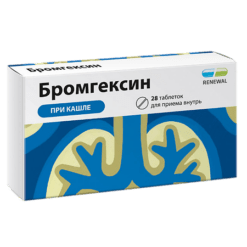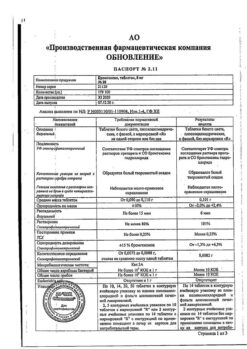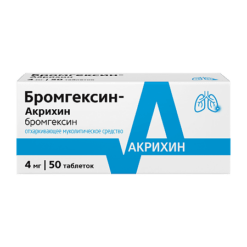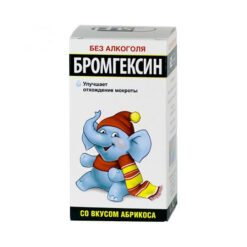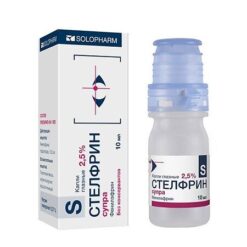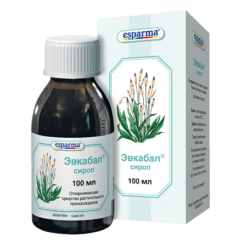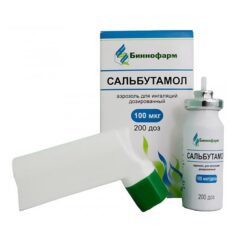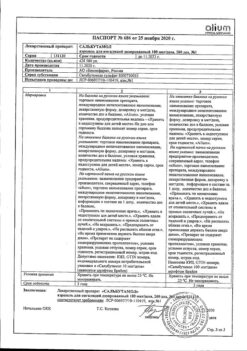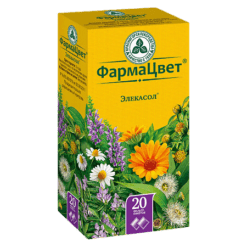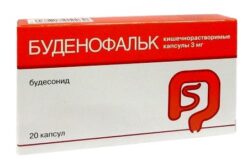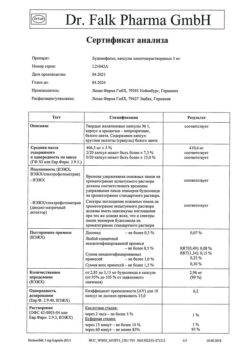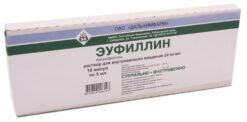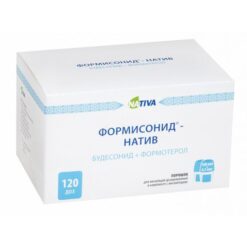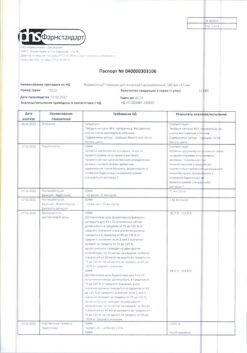No products in the cart.
Bromhexin, 4 mg/5 ml 60 ml
€1.00
Out of stock
(E-mail when Stock is available)
Description
Pharmacotherapeutic group: expectorant mucolytic agent
ATX code: [R05CB02]
Pharmacological properties
Pharmacodynamics.
Bromhexin Nicomed has mucolytic (secretolytic), expectorant and mild anti-cough.
Mucolytic effect is associated with depolymerization of mucoprotein and mucopolysaccharide fibers and an increase in the serous component of bronchial secretion.
Pharmacokinetics
In oral administration, bromhexine is almost completely (99%) absorbed in the gastrointestinal tract within 30 minutes. Bioavailability depends on the individual characteristics of the body, the activity of renal enzymes during the primary passage of the active substance through the liver and is about 20%. Bromhexin in plasma binds to proteins, penetrates through the blood-brain and placental barriers.
In the liver bromhexine undergoes demethylation and oxidation, part of the resulting metabolites (ambroxol) retains activity. Limit half-life is 15 hours due to slow reverse diffusion from tissues. Maximum concentration in blood is reached about 1 hour after intake. It is excreted by the kidneys. Excretion of bromhexin metabolites is impaired in chronic renal failure. Bromhexin may cumulate with repeated use.
Indications
Indications
Acute and chronic bronchopulmonary diseases, accompanied by the formation of high-viscosity sputum (bronchial asthma, pneumonia, tracheobronchitis, obstructive bronchitis, bronchiectasis, pulmonary emphysema, cystic fibrosis, tuberculosis, pneumoconiosis).
Sanitation of the bronchial tree in the preoperative period and during therapeutic and diagnostic intrabronchial manipulations, prevention of accumulation of thick viscous Sputum in the bronchi after surgery.
Pharmacological effect
Pharmacological effect
Pharmacotherapeutic group: mucolytic expectorant
ATX code: [R05CB02]
Pharmacological properties
Pharmacodynamics.
Bromhexine Nycomed has a mucolytic (secretolytic), expectorant and weak antitussive effect.
The mucolytic effect is associated with the depolymerization of mucoprotein and mucopolysaccharide fibers and an increase in the serous component of bronchial secretions.
Pharmacokinetics
When taken orally, bromhexine is almost completely (99%) absorbed from the gastrointestinal tract within 30 minutes. Bioavailability depends on the individual characteristics of the body, the activity of renal enzymes during the initial passage of the active substance through the liver and is approximately 20%. Bromhexine in plasma binds to proteins and penetrates the blood-brain and placental barriers.
In the liver, bromhexine undergoes demethylation and oxidation; some of the resulting metabolites (ambroxol) remain active. The maximum half-life is 15 hours due to slow reverse diffusion from tissues. The maximum concentration in the blood is reached approximately 1 hour after administration. Excreted by the kidneys. In chronic renal failure, the release of bromhexine metabolites is impaired. With repeated use, bromhexine may accumulate.
Special instructions
Special instructions
For patients with diabetes mellitus: 5 ml of solution contains 1.5 g of sorbitol, which corresponds to 0.12 bread units.
The drug contains alcohol in a concentration of 3%, which is 0.6 g per dose of the drug for adults (20 ml), respectively, for children (2.5 ml) – 0.075 g.
Impact on the ability to drive vehicles and equipment
Taking the recommended therapeutic doses (20 ml 3 times a day) does not affect the speed of the patient’s psychomotor reactions.
Significantly exceeding the recommended doses of a drug containing 3% alcohol can affect the speed of psychomotor reactions and pose a danger when driving a car or working with equipment.
Active ingredient
Active ingredient
Bromhexine
Composition
Composition
1 ml of solution contains:
Active substance:
Bromhexine hydrochloride. – 0.8 mg
Excipients: levomenthol 0.068 mg; hydrochloric acid 2 mol/l to pH 3.0; methyl parahydroxy benzoate 1.64 mg; ethanol 96% 30.0 mg; sorbitol 300.0 mg; purified water 762.0 mg.
Contraindications
Contraindications
– hypersensitivity to the components of the drug;
– pregnancy and lactation;
– peptic ulcer (in the acute stage);
– children under 3 years of age.
Use with caution in patients with a history of gastric bleeding, with bronchial diseases accompanied by excessive accumulation of secretions, with a history of episodes of hemoptysis, renal and/or liver failure.
The presence of alcohol in the drug (3%) may have an adverse effect on children, pregnant women, people with brain diseases, traumatic brain injury, and alcoholism.
Side Effects
Side Effects
Rarely, long-term use of the drug may cause dyspepsia, incl. nausea, vomiting, exacerbation of gastric and duodenal ulcers, allergic reactions, dizziness, headache, increased activity of “liver” transaminases in the blood serum.
Interaction
Interaction
Bromhexine Nycomed is not prescribed simultaneously with antitussives (including those containing codeine), because they may make it difficult to cough up sputum diluted with Bromhexine Nycomed.
Bromhexine Nycomed promotes the penetration of antibiotics (erythromycin, cephalexin, oxytetracycline, ampicillin, amoxicillin), sulfonamide drugs into bronchial secretions.
The drug is incompatible with alkaline solutions.
Overdose
Overdose
Life-threatening overdoses when using Bromhexine Nycomed in humans are not known.
Possible symptoms include nausea, vomiting, diarrhea and other gastrointestinal disorders.
Treatment: There is no specific antidote. In case of overdose, it is necessary to induce vomiting, and then give the patient liquid (milk or water). Gastric lavage is recommended within 1-2 hours after taking the drug.
Storage conditions
Storage conditions
Store at temperatures from +15 to +25 °C.
Keep out of the reach of children.
Shelf life
Shelf life
3 years. Do not use after expiration date.
Manufacturer
Manufacturer
Ozon, Russia
Additional information
| Shelf life | 3 years. Do not use after the expiration date. |
|---|---|
| Conditions of storage | Store at temperatures from +15 to +25 ° C. Keep out of reach of children. |
| Manufacturer | Ozon, Russia |
| Medication form | oral solution |
| Brand | Ozon |
Other forms…
Related products
Buy Bromhexin, 4 mg/5 ml 60 ml with delivery to USA, UK, Europe and over 120 other countries.

